如何在 Matplotlib 中改变子图的大小和间距
Suraj Joshi
2023年1月30日
Matplotlib
Matplotlib Subplot
-
tight_layout()方法更改 Matplotlib 子图大小和间距 -
plt.subplots_adjust()方法更改 Matplotlib 子图间距 -
plt.subplot_tool()方法更改 Matplotlib 子图大小和间距 -
在子图中激活
constrained_layout=True

我们可以使用 tight_layout(),subplots_adjust() 和 subplot_tool() 方法来更改 Matplotlib 中许多子图的子图大小或间距。我们还可以通过在 subplots() 函数中设置 constrained_layout=True 来更改子图间距。
tight_layout() 方法更改 Matplotlib 子图大小和间距
tight_layout() 方法会自动保持子图之间的正确间距。
import numpy as np
import matplotlib.pyplot as plt
x = np.linspace(-3, 3, 100)
y1 = np.sin(x)
y2 = np.cos(x)
y3 = 1 / (1 + np.exp(-x))
y4 = np.exp(x)
fig, ax = plt.subplots(2, 2)
ax[0, 0].plot(x, y1)
ax[0, 1].plot(x, y2)
ax[1, 0].plot(x, y3)
ax[1, 1].plot(x, y4)
ax[0, 0].set_title("Sine function")
ax[0, 1].set_title("Cosine function")
ax[1, 0].set_title("Sigmoid function")
ax[1, 1].set_title("Exponential function")
fig.tight_layout()
plt.show()
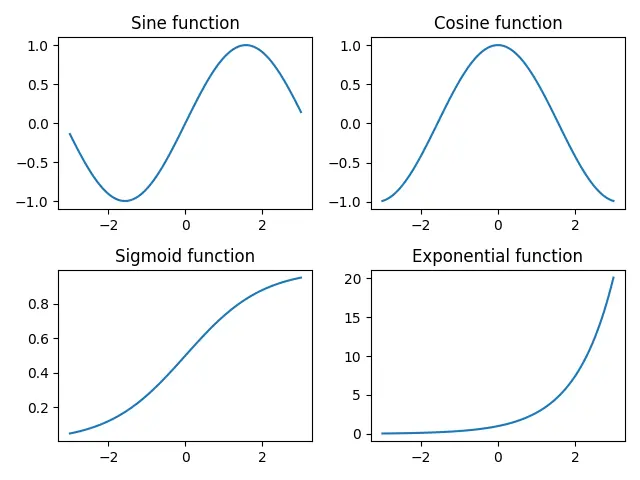
如果我们不使用 tight_layout() 方法,则一行将与下一行的标题重叠。
import numpy as np
import matplotlib.pyplot as plt
x = np.linspace(-3, 3, 100)
y1 = np.sin(x)
y2 = np.cos(x)
y3 = 1 / (1 + np.exp(-x))
y4 = np.exp(x)
fig, ax = plt.subplots(2, 2)
ax[0, 0].plot(x, y1)
ax[0, 1].plot(x, y2)
ax[1, 0].plot(x, y3)
ax[1, 1].plot(x, y4)
ax[0, 0].set_title("Sine function")
ax[0, 1].set_title("Cosine function")
ax[1, 0].set_title("Sigmoid function")
ax[1, 1].set_title("Exponential function")
plt.show()
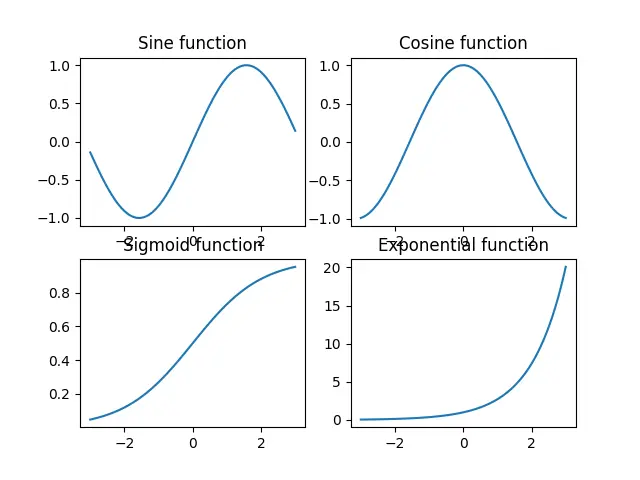
plt.subplots_adjust() 方法更改 Matplotlib 子图间距
我们可以使用 plt.subplots_adjust() 方法来更改子图之间的间距。
import numpy as np
import matplotlib.pyplot as plt
x = np.linspace(-3, 3, 100)
y1 = np.sin(x)
y2 = np.cos(x)
y3 = 1 / (1 + np.exp(-x))
y4 = np.exp(x)
fig, ax = plt.subplots(2, 2)
ax[0, 0].plot(x, y1)
ax[0, 1].plot(x, y2)
ax[1, 0].plot(x, y3)
ax[1, 1].plot(x, y4)
ax[0, 0].set_title("Sine function")
ax[0, 1].set_title("Cosine function")
ax[1, 0].set_title("Sigmoid function")
ax[1, 1].set_title("Exponential function")
plt.subplots_adjust(left=0.125, bottom=0.1, right=0.9, top=0.9, wspace=0.2, hspace=0.35)
plt.show()
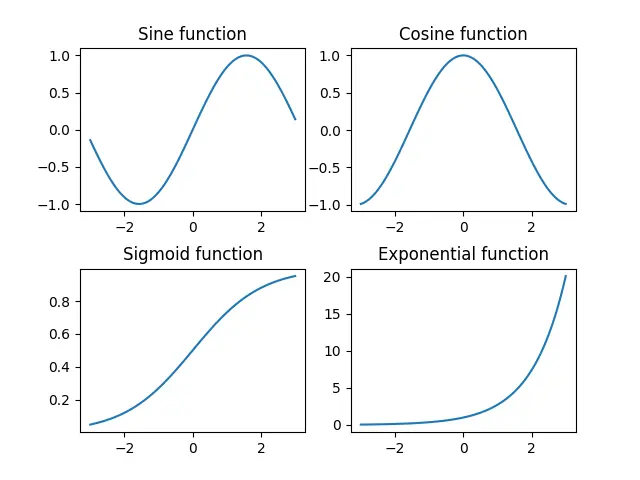
plt.subplots_adjust(left=0.125, bottom=0.1, right=0.9, top=0.9, wspace=0.2, hspace=0.35)
wspace 和 hspace 指定子图之间保留的空间。它们分别是轴的宽度和高度的分数。
left,right,top 和 bottom 参数指定了子图的四个边的位置。它们是图形的宽度和高度的比例。
plt.subplot_tool() 方法更改 Matplotlib 子图大小和间距
此方法将启动图形的子图工具窗口。
import numpy as np
import matplotlib.pyplot as plt
im1 = np.random.random((50, 50))
im2 = np.random.random((40, 50))
im3 = np.random.random((50, 40))
im4 = np.random.random((60, 50))
plt.subplot(221)
plt.imshow(im1)
plt.subplot(222)
plt.imshow(im2)
plt.subplot(223)
plt.imshow(im3)
plt.subplot(224)
plt.imshow(im4)
plt.subplot_tool()
plt.show()
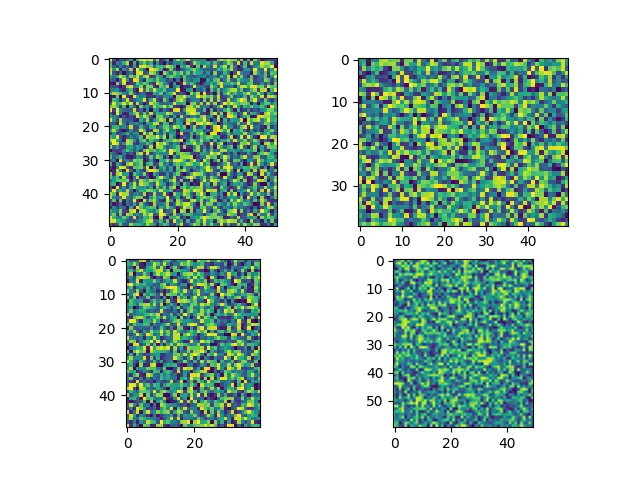
它为用户提供了一种交互式方法来拖动 subplot_tool 中的条以更改子图的布局。
在子图中激活 constrained_layout=True
constrained_layout 会自动调整子图和装饰,使其尽可能地适合图中。
必须在创建子图之前或期间激活 constrained_layout,因为它会在每个绘制步骤之前优化布局。
import numpy as np
import matplotlib.pyplot as plt
a = np.linspace(0, 5, 100)
figure, axes = plt.subplots(2, 2, constrained_layout=True)
axes[0, 0].plot(x, np.exp(a))
axes[0, 1].plot(a, np.sin(a))
axes[1, 0].plot(a, np.cos(a))
axes[1, 1].plot(range(10))
axes[0, 0].set_title("subplot 1")
axes[0, 1].set_title("subplot 2")
axes[1, 0].set_title("subplot 3")
axes[1, 1].set_title("subplot 4")
plt.show()
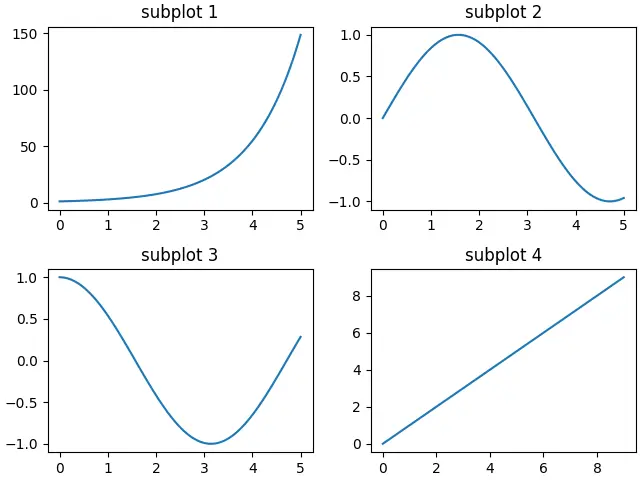
Enjoying our tutorials? Subscribe to DelftStack on YouTube to support us in creating more high-quality video guides. Subscribe
作者: Suraj Joshi
Suraj Joshi is a backend software engineer at Matrice.ai.
LinkedIn